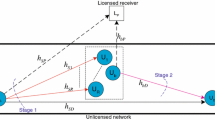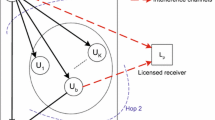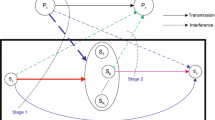Abstract
This paper provides a general outage analysis framework for cooperative cognitive networks with proactive relay selection over non-identical Rayleigh fading channels and under both maximum transmit power and interference power constraints. We firstly propose an exact closed-form outage probability expression, which is then exploited for determining the diversity order and coding gain for proactive relay selection scenarios as well as deriving system performance limits at either large maximum transmit power or large maximum interference power. The derived performance metrics bring several insights into system performance behavior without the need of time-consuming Monte-Carlo simulations. Various results confirm the validity of the proposed derivations and show that cooperative cognitive networks with proactive relay selection incur performance saturation and their performance depends considerably on the number of involved relays. In addition, cooperative cognitive networks are significantly better than dual-hop counterparts without any cost of system resources.




Similar content being viewed by others
Notes
Due to the nature of regenerating the received information without noise enhancement, the DF relays are investigated in this paper and hence, literature survey relevant to the AF relays are not necessarily presented (e.g., [2]).
This means that \({\uplambda }_{tr}\) is the inverse of the fading power of the channel between the transmitter t and the receiver r, i.e., \({\uplambda }_{tr}=1/\mathcal {E}_{\left| h_{tr}\right| ^2}\{{\left| h_{tr} \right| ^2}\}\) where \(\mathcal {E}_X\{\cdot \}\) denotes the statistical expectation over the random variable X.
Some authors (e.g., [10]) also refer this scheme as the max-min relay selection.
Due to the nature of two-stage cooperative communications, the system capacity is given as \(C=\frac{1}{2}\log _2(1+\gamma _{SC})\). The capacity outage happens if \(C<U\) where U is the required transmission rate. Equivalently, the outage event happens if \(\gamma _{SC}<z\) where \(z=2^{2U}-1\), which shows the relation between the required transmission rate U and the SNR threshold z. For example, \(z=3,15\) corresponds \(U=1,2\) bps/Hz, respectively.
The Monte-Carlo simulation is well-known, e.g. [31], and hence, a description of how it is conducted is omitted.
References
Lee, J., Wang, H., Andrews, J. G., & Hong, D. (2011). Outage probability of cognitive relay networks with interference constraints. IEEE Transactions on Wireless Communications, 10(2), 390–395.
Xia, M., & Aissa, S. (2013). Underlay cooperative AF relaying in cellular networks: Performance and challenges. IEEE Communications Magazine, 51(12), 170–176.
Zhang, Z., Zhang, W., & Tellambura, C. (2009). OFDMA uplink frequency offset estimation via cooperative relaying. IEEE Transactions on Wireless Communications, 8(9), 4450–4456.
Nabar, R. U., Bolcskei, H., & Kneubuhler, F. W. (2004). Fading relay channels: Performance limits and space–time signal design. IEEE Journal on Selected Areas in Communications, 22(6), 1099–1109.
Zhuang, W., & Ismail, M. (2012). Cooperation in wireless communication networks. IEEE Wireless Communications, 19(2), 10–20.
Zhang, Z., Zhang, W., & Tellambura, C. (2009). Cooperative OFDM channel estimation in the presence of frequency offsets. IEEE Transactions on Vehicular Technology, 58(7), 3447–3459.
Laneman, J. N., & Wornell, G. W. (2003). Distributed spacetime-coded protocols for exploiting cooperative diversity in wireless networks. IEEE Transactions on Information Theory, 49(10), 2415–2425.
Laneman, J. N., Tse, D. N. C., & Wornell, G. W. (2004). Cooperative diversity in wireless networks: Efficient protocols and outage behavior. IEEE Transactions on Information Theory, 50(12), 3062–3080.
Yeoh, P. L., Elkashlan, M., Chen, Z., & Collings, I. B. (2011). SER of multiple amplify-and-forward relays with selection diversity. IEEE Transactions on Communications, 59(8), 2078–2083.
Bletsas, A., Khisti, A., Reed, D. P., & Lippman, A. (2006). Simple cooperative diversity method based on network path selection. IEEE Journal on Selected Areas in Communications, 24(3), 659–672.
Yan, Z., Zhang, X., & Wang, W. (2011). Exact outage performance of cognitive relay networks with maximum transmit power limits. IEEE Communications Letters, 15(12), 1317–1319.
Sun, H., & Naraghi-Pour, M. (2014). Decode-and-forward relay selection with imperfect CSI in cognitive relay networks. In Proceedings of IEEE military communications conference, Baltimore, Maryland, USA, pp. 416–421, Oct. 6–8.
Liping, L., Zhang, P., Zhang, G., & Qin, J. (2011). Outage performance for cognitive relay networks with underlay spectrum sharing. IEEE Communications Letters, 15(7), 710–712.
Si, J., Li, Z., Chen, X., Hao, B. J., & Liu, Z. J. (2011). On the performance of cognitive relay networks under primary user’s outage constraint. IEEE Communications Letters, 15(4), 422–424.
Zhang, X., Yan, Z., Gao, Y., & Wang, W. (2013). On the study of outage performance for cognitive relay networks (CRN) with the Nth best-relay selection in Rayleigh-fading channels. IEEE Wireless Communications Letters, 2(1), 110–113.
Ding, H., Ge, J., da Costa, D. B., & Jiang, Z. (2011). Asymptotic analysis of cooperative diversity systems with relay selection in a spectrum-sharing scenario. IEEE Transactions on Vehicular Technology, 60, 457–472.
Zhang, X., Xing, J., Yan, Z., Gao, Y., & Wang, W. (2013). Outage performance study of cognitive relay networks with imperfect channel knowledge. IEEE Communications Letters, 17(1), 27–30.
Giang, N.H., Bao, V.N.Q., & Le, H.N. (2013). Cognitive underlay communications with imperfect CSI: Network design and performance analysis. In Proceedings of IEEE ATC, HoChiMinh City, Vietnam, pp. 18–22, 15–17.
Thanh, T. L., Bao, V. N. Q., & An, B. (2013). On the performance of outage probability in underlay cognitive radio with imperfect CSI. In Proceedings of IEEE ATC, HoChiMinh City, Vietnam, pp. 125–130, 15–17.
Wu, Q., Zhang, Z., & Wang, J. (2013). Outage analysis of cognitive relay networks with relay selection under imperfect CSI environment. IEEE Communications Letters, 17(7), 1297–1300.
Si, J., Li, Z., Huang, H., Chen, J., & Gao, R. (2012). Capacity analysis of cognitive relay networks with the PU’s interference. IEEE Communications Letters, 16(12), 2020–2023.
Bao, V. N. Q., & Duong, T. Q. (2012). Exact outage probability of cognitive underlay DF relay networks with best relay selection. IEICE Transactions on Communications, E95–B(6), 2169–2173.
Mokari, N., Parsaeefard, S., Saeedi, H., Azmi, P., & Hossain, E. (2015). Secure robust ergodic uplink resource allocation in relay assisted cognitive radio networks. IEEE Transactions on Signal Processing, 63(2), 291–304.
Chen, Y., Ge, J., & Bu, Q. (2014). Outage and diversity analysis of cognitive relay networks with direct link under interference constraints over Nakagami-m fading. In Proceedings of IEEE CIT, Xian, Shaanxi, China, 11–13, pp. 88–93.
Hanif, M., Yang, H. C., & Alouini, M. S. (2015). Receive antenna selection for underlay cognitive radio with instantaneous interference constraint. IEEE Signal Processing Letters, 22(6), 738–742.
Vucetic, B., & Yuan, J. (2003). Space–time coding. New Jersey: Wiley.
Papoulis, A., & Pillai, S. U. (2002). Probability, random variables, and stochastic processes (4th ed.). New York: McGraw-Hill.
Ibrahim, A. S., Sadek, A. K., Su, W., & Liu, K. J. R. (2006). Relay selection in multi-node cooperative communications: When to cooperate and whom to cooperate with?. In Proceedings of IEEE GlobeCom, pp. 1–5.
Duong, T. Q., da Costa, D. B., Elkashlan, M., & Bao, V. N. Q. (2012). Cognitive amplify-and-forward relay networks over Nakagami-m fading. IEEE Transactions on Vehicular Technology, 61(5), 2368–2374.
Duong, T. Q., da Costa, D. B., Tsiftsis, T. A., Zhong, C., & Nallanathan, A. (2012). Outage and diversity of cognitive relaying systems under spectrum sharing environments in Nakagami-m fading. IEEE Communications Letters, 16(12), 2075–2078.
Thomopoulos, N. T. (2013). Essentials of Monte Carlo simulation: Statistical methods for building simulation models. New York: Springer.
Acknowledgments
This research is funded by Vietnam National Foundation for Science and Technology Development (NAFOSTED) under Grant Number 102.04-2014.42
Author information
Authors and Affiliations
Corresponding author
Appendices
Appendix 1: Proof of Lemma 1
We rewrite \(\mathcal {G}_1\) in (21) as
Using the equality \(\prod \limits _{k = 1}^K {\left( {1 + {a_k}} \right) } = 1 + \sum \limits _{u = 1}^{K - 1} {\sum \limits _{{s_1} = 1}^{K - u + 1} {\sum \limits _{{s_2} = {s_1} + 1}^{K - u + 2} { \cdots \sum \limits _{{s_u} = {s_{u - 1}} + 1}^K {\prod \limits _{l = 1}^u {{a_{{s_l}}}} } } } } + \prod \limits _{k = 1}^K {{a_k}}\), one obtains
where
It is noted that the integral in (28) is completely solved in closed-form by integrating by parts. Plugging the above into (27), one obtains (22) where
Substituting (28) in the above, we reduce (29) to
Using the fact that \({f_{{Y_q}}}\left( {{y_q}} \right) = {{\uplambda }_{{R_q}L}}{e^{ - {{\uplambda }_{{R_q}L}}{y_q}}}\), one can solve the integral in (30) in closed-form as follows
where the second integral is solved by integrating by parts.
Inserting (31) into (30), the closed form of \(\tilde{\mathcal {G}}_{1i}\) can be expressed as (23), which completes the proof.
Appendix 2: Proof of Lemma 2
We rewrite \(\mathcal {G}_2\) in (21) as
It is straightforward to infer that \(\int \limits _0^\tau {{f_X}\left( x \right) dx} = 1 - {e^{ - {{\uplambda }_{SL}}\tau }}\) and \({\int \limits _0^\infty {{f_{{Y_k}}}\left( {{y_k}} \right) d{y_k}} }=1\) while \(\int \limits _0^\infty {\frac{{{f_{{Y_k}}}\left( {{y_k}} \right) }}{{\min \left( {y_k^{ - 1}\tau ,1} \right) }}d{y_k}} = 1 + \frac{{{e^{ - {{\uplambda }_{{R_k}L}}\tau }}}}{{{{\uplambda }_{{R_k}L}}\tau }}\) with the aid of (31). Plugging all these results in (32), one obtains (24) which completes the proof.
Rights and permissions
About this article
Cite this article
Ho-Van, K. On the performance of cooperative cognitive networks with proactive relay selection. Wireless Netw 22, 2131–2141 (2016). https://doi.org/10.1007/s11276-015-1090-1
Published:
Issue Date:
DOI: https://doi.org/10.1007/s11276-015-1090-1




